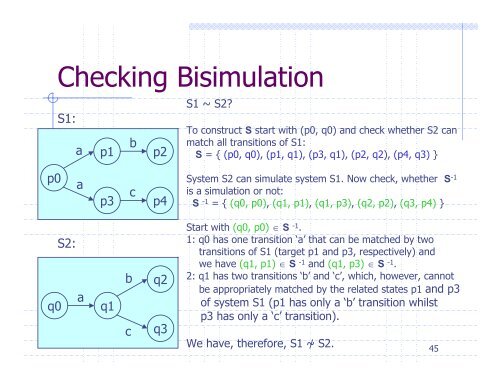Strong Bisimulation
Strong Bisimulation
Strong Bisimulation
You also want an ePaper? Increase the reach of your titles
YUMPU automatically turns print PDFs into web optimized ePapers that Google loves.
Checking <strong>Bisimulation</strong><br />
S1:<br />
a<br />
p1<br />
b<br />
p2<br />
S1 ~ S2?<br />
To construct S start with (p0, q0) and check whether S2 can<br />
match all transitions of S1:<br />
S = { (p0, q0), (p1, q1), (p3, q1), (p2, q2), (p4, q3) }<br />
p0<br />
a<br />
p3<br />
c<br />
p4<br />
System S2 can simulate system S1. Now check, whether S -1<br />
is a simulation or not:<br />
S -1 = { (q0, p0), (q1, p1), (q1, p3), (q2, p2), (q3, p4) }<br />
q0<br />
S2:<br />
a<br />
q1<br />
b<br />
c<br />
q2<br />
q3<br />
Start with (q0, p0) ∈ S -1 .<br />
1: q0 has one transition ‘a’ that can be matched by two<br />
transitions of S1 (target p1 and p3, respectively) and<br />
we have (q1, p1) ∈ S -1 and (q1, p3) ∈ S -1 .<br />
2: q1 has two transitions ‘b’ and ‘c’, which, however, cannot<br />
be appropriately matched by the related states p1 and p3<br />
of system S1 (p1 has only a ‘b’ transition whilst<br />
p3 has only a ‘c’ transition).<br />
We have, therefore, S1 ~ / S2.<br />
45
















